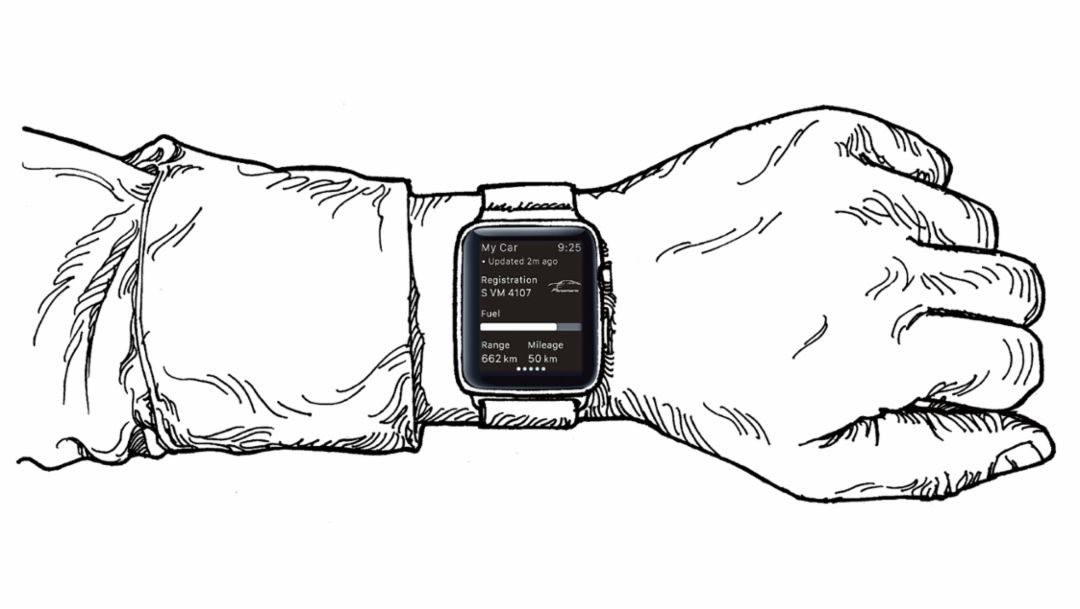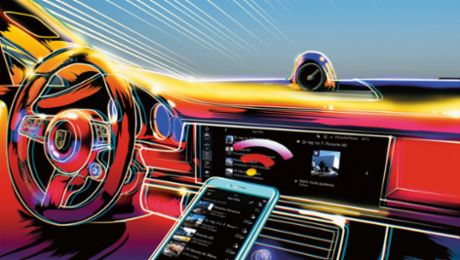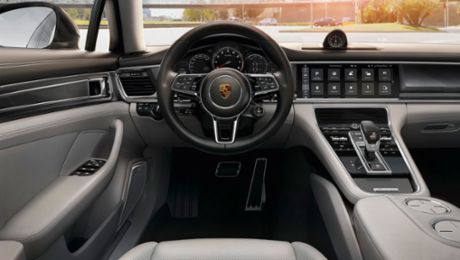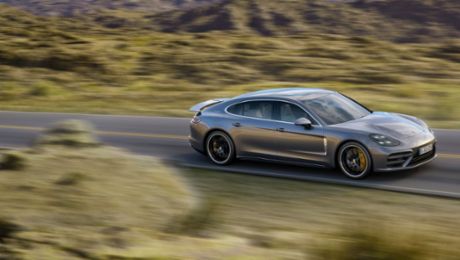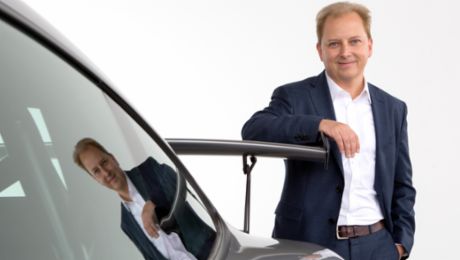In theory, Porsche drivers soon won’t even need to get out of their cars. Introduced in late June, Porsche Connect has, once and for all, turned the car into a rolling command center. In the future, there will be almost nothing that you can’t do with ease while on the road. For instance, getting information about flights or events in a particular city, searching for parking spots or charging stations online, calling up your personal agenda—and of course, all the services available previously, such as real-time traffic information, or displaying vehicle data as well.
The do-it-all communication tool Porsche Connect is now available for the first time in the new Panamera—as a standard feature. It will subsequently become available for all other models, in some cases as an option, and in some cases as standard. Much of the content in the Porsche Communication Management (PCM) system can be configured, updated and personalized using the also newly launched Porsche Connect Portal and the new Porsche Connect Store.
Connected Car concept encompasses functions inside or outside of the vehicle
Of course, the primary focus of the sports cars from Zuffenhausen and Leipzig is their outstanding driving characteristics. But the subject of connectivity is an increasingly key area for Porsche. For almost three years, an interdepartmental team has been working on building up this new business area. “Among other measures, the new Connected Car department was set up under the Sales and Marketing unit in order to promote development in this field more keenly,” says Daniel Vetterkind, Manager of Customer Communications Sales and Marketing Connected Car (VMC). At Porsche, the Connected Car concept encompasses functions inside or outside of the vehicle that make data exchange possible—for example between a Porsche and a smartphone, or between multiple vehicles.
The company offers a variety of different applications. With the Porsche Car Connect app, users can access vehicle information such as the current fuel level, remaining range, or the average fuel consumption on the last trip. The app also enables remote control of certain vehicle functions, such as retracting the mirrors or locking the vehicle. The Porsche Vehicle Tracking System is also controlled using the Car Connect app. In the event of a theft, vehicle data is sent directly to an alarm center, the Porsche owner is informed via the app and by text message, and local authorities are notified. In the event of an emergency or breakdown, Car Connect sends important vehicle data and the location of the car to an alarm center or to Porsche Assistance. Porsche Car Connect works with Android and Apple smartphones. The latter can also be connected with the Apple Watch, allowing Car Connect app functions to be operated using the watch as well.
PCM has already proven itself on the market as the central control unit for audio, navigation and communication. The system features a wireless internet connection, real-time traffic information, Google Earth, Google Street View and Apple Car Play—with which iPhone apps can be displayed and operated on the PCM screen. Also practical is the smartphone tray in the center console, which connects your smartphone to the external antenna to provide improved reception quality and save your phone’s battery charge by reducing power consumption. “Using a data SIM card, there is an internet connection for our online services in the vehicle, as well as for use by other occupants of the vehicle,” adds Vetterkind. Older versions of the PCM system can also be connected to the smartphone app “Aha Radio”. The user can therefore access continuously updated real-time traffic data, listen to web radio, or input searched addresses as the destination during the trip.
Daniel Vetterkind and his colleagues are already working feverishly on developing and refining Porsche Connect further: “Once launched, we will be offering Porsche Connect in more than 40 countries around the world.” Different countries, different customs: In China, says Vetterkind, Porsche buyers are an average of ten years younger than in Europe. As a result, customer needs are also different: “There we are already offering a concierge service allowing users to issue instructions from the car, for example to have a table reserved at the restaurant of their choice.” The company provides this service to its customers in China and Japan around the clock, seven days a week.
Consumption data
Panamera: combined fuel consumption 7.6 – 7.5 l/100 km; CO2 emissions: 173 – 171 g/km
Panamera 4: combined fuel consumption 7.8 – 7.7 l/100 km; CO2 emissions: 177 – 175 g/km
Panamera 4 Executive: combined fuel consumption 7.9 – 7.8 l/100 km; CO2 emissions: 180 – 178 g/km
Panamera 4S: combined fuel consumption 8.2 – 8.1 l/100 km; CO2 emissions: 186 – 184 g/km
Panamera 4S Executive: combined fuel consumption 8.3 – 8.2 l/100 km; CO2 emissions: 189 – 187 g/km
Panamera 4S Diesel: combined fuel consumption 6.8 – 6.7 l/100 km; CO2 emissions: 178 – 176 g/km
Panamera Turbo: combined fuel consumption 9.4 – 9.3 l/100 km; CO2 emissions: 214 – 212 g/km
Panamera Turbo Executive: combined fuel consumption 9.5 – 9.4 l/100 km; CO2 emissions: 217 – 215 g/km
Panamera 4 E-Hybrid: combined fuel consumption 2.5 l/100 km; electricity consumption 15.9 kWh/100 km; CO2 emissions 56 g/km; efficiency class (Germany): A+
Panamera 4 E-Hybrid Executive: combined fuel consumption 2.5 l/100 km; electricity consumption 15.9 kWh/100 km; CO2 emissions 56 g/km; efficiency class (Germany): A+

